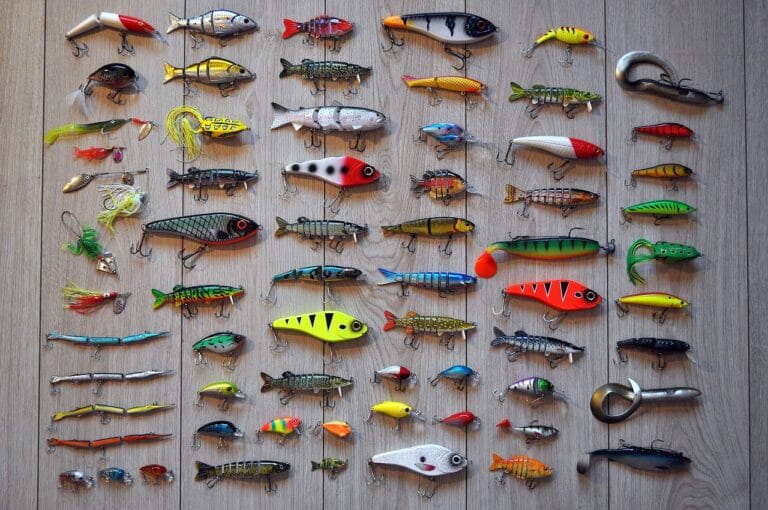Best Heavy Spoons for Monster Pike 2025 – Metal Lures Proven to Trigger Deep Cold-Water Strikes
When the water drops below 8°C (46°F) and everything slows down, most lures lose their magic — but not spoons. In those freezing depths where big pike lurk, heavy metal is still king. The flash, vibration, and sheer presence of a well-worked spoon can wake even the laziest predator out of its winter trance. It’s not about speed anymore — it’s about precision, control, and finding that perfect rhythm that triggers a single, violent strike.

As an Amazon Associate, we earn from qualifying purchases — no cost to you. That’s how we keep this site running. Read more ›
In this guide, I’ll show you the best heavy spoons for monster pike in 2025, how to fish them effectively in deep, cold water, and what setups keep your lure running flawlessly when everything else freezes up. Whether you fish from shore, kayak, or boat, this is the metal game you want to master this winter.
Why Heavy Spoons Still Dominate Deep, Cold-Water Pike Fishing
Decades after their invention, spoons remain one of the most consistent lures for catching giant pike — and in deep, cold-water conditions, heavy versions dominate. Their dense construction allows long casts, fast sink rates, and a slow, controlled flutter that mimics wounded baitfish perfectly. When pike shift to deeper thermoclines during winter, spoons reach them faster and stay in the strike zone longer than any soft plastic or jerkbait.
The physics behind it is simple: heavy spoons create deep vibration and strong visual flash that cut through dense, cold water. While other lures stiffen or lose action, spoons maintain consistent movement and visibility. The result? More bites when nothing else works. That’s why top anglers still keep a few reliable slabs of metal in their winter tackle box — because when it’s cold, metal wins.
In 2025, new finishes, corrosion-resistant coatings, and refined shapes have made heavy spoons even deadlier. Brands like Abu Garcia, Mepps, Williams, and Kuusamo continue to dominate this category — and in the next sections, we’ll break down which specific models truly deliver monster results.
Pike Behavior: Understanding the Cold-Water Strike Zone (°C / °F Guide)
Fishing for pike in cold water is a completely different game compared to the warmer months. As temperatures drop and oxygen levels shift, pike settle into deep strike zones where heavy spoons and slow retrieves become your best weapons.To understand why spoons work so well in winter, you first need to understand how pike behavior changes with temperature. As the water cools below 10°C (50°F), a pike’s metabolism slows drastically. It digests food slower, moves less, and becomes more selective — attacking only when the opportunity looks perfect. That’s where a heavy spoon excels: it offers the perfect combination of flash and vibration without forcing the fish to chase too hard.

During winter, when most lures stop working, a properly tuned heavy spoon remains one of the most reliable options for pike in cold water environments.In deeper water — typically between 3 and 8 meters (10–26 feet) — oxygen levels stabilize, and pike position themselves near drop-offs, channels, and submerged weed lines. They wait for a slow-moving baitfish to flutter by. That’s why a heavy spoon, falling naturally through the water column, perfectly imitates that dying movement and triggers a strike from even the most passive predator.
Here’s a quick look at how temperature affects their feeding behavior and the ideal spoon setup for each range:
| Depth (m / ft) | Water Temperature (°C / °F) | Pike Activity Level | Recommended Spoon Weight (g / oz) |
|---|---|---|---|
| 2–4 m / 6–13 ft | 10–12°C / 50–54°F | Active – chasing baitfish near structure | 20–25 g / 0.7–0.9 oz |
| 4–6 m / 13–20 ft | 8–10°C / 46–50°F | Moderate – slower reaction but still alert | 25–35 g / 0.9–1.2 oz |
| 6–8 m / 20–26 ft | 5–7°C / 41–45°F | Low activity – holding tight to bottom zones | 35–45 g / 1.2–1.6 oz |
| 8–10 m / 26–33 ft | 3–5°C / 37–41°F | Very sluggish – strikes only on slow flutter | 45–55 g / 1.6–1.9 oz |
| 10+ m / 33+ ft | Below 3°C / 37°F | Almost inactive – reaction bites only, vertical jigging required | 55–70 g / 1.9–2.4 oz |
Notice how spoon weight increases as temperature drops. Heavier metal keeps you in the strike zone longer and gives better control in deeper, denser water. Combine that with a steady retrieve and extended pauses, and you’ll stay in front of the few predators still willing to feed. When everything else stops working, a heavy spoon is often the last lure standing.
How to Fish a Heavy Spoon for Trophy Pike: The Slow-Motion Technique That Catches Giants
When it comes to catching trophy pike in cold water, the key isn’t aggression — it’s control. Heavy spoons allow you to reach deep strike zones, stay there longer, and create just enough flash to trigger a bite. The goal is not to make the spoon dance wildly, but to make it look like an injured baitfish struggling to stay alive. Every movement should look effortless, slow, and believable.

Retrieve Techniques
The best retrieve for winter pike is the slow flutter and pause. Cast long, let the spoon sink completely, then lift your rod tip slowly and let it fall back on a semi-slack line. Pike often strike as the spoon flutters down — not when it’s being retrieved. If you’re fishing from a boat or kayak, vertical jigging works even better, letting the spoon rise and fall naturally in front of stationary fish.
In slightly warmer water (around 8–10°C / 46–50°F), mix in a stop-and-go retrieve: short pulls of the rod, one-second pauses, and a steady rhythm. The goal is to imitate a weak fish trying to escape, then suddenly giving up. Always keep your line tight, because cold-water pike often strike with subtle tension rather than explosive hits.
Depth & Speed Control
Depth is everything when fishing spoons in cold conditions. Pike can move vertically several meters to inspect a lure, but they rarely chase horizontally for long. The sweet spot is usually mid-depth to bottom — around 3 to 8 meters (10–26 feet) — where oxygen levels, water temperature, and baitfish schools remain most stable. This “comfort zone” gives pike minimal energy loss while waiting for easy prey, making it the most productive layer for slow spoon presentations.
Keep retrieve speed consistent and deliberate. Think slow-motion precision, not reaction time. When your spoon hits structure — rocks, weeds, or submerged timber — pause for two or three seconds before lifting again. That pause often triggers an instant strike from a big pike hovering nearby.
Rod & Reel Setup
For heavy spoon fishing, you need a setup that handles both casting distance and hook-setting power. A 7–8 ft (2.1–2.4 m) medium-heavy spinning rod gives you enough backbone to drive hooks in deep water but still allows sensitive control of lure action. Pair it with a 4000–5000 size spinning reel and smooth drag performance — something like the models featured in our Best Reels for Pike Fishing in Cold Water 2025 guide.
As for line, a 0.20–0.25 mm braid (20–25 lb / 9–11 kg) gives excellent control with minimal stretch, while a heavy fluorocarbon leader (40–50 lb / 18–23 kg) is mandatory to protect against bite-offs from large pike — it’s our recommended setup for cold-water fishing. If you’re fishing from a boat, spool up slightly heavier to handle vertical strikes and sudden lunges from monster fish.
Top 5 Heavy Spoons for Monster Pike 2025 – Cold-Water Lures That Actually Catch Giants

When the water drops below 10°C (50°F), only a handful of lures truly deliver — and heavy spoons stand at the top of that list. These metal predators produce the perfect mix of flash, vibration, and slow fall that cold-water pike simply can’t ignore. Below are five deadly spoons that have been proven by professional anglers season after season to trigger strikes when nothing else works. Each one is a serious cold-water weapon — the kind of lure every dedicated pike hunter should own.
1. Eppinger Daredevle Spoon
Best colors: Red/White, Yellow/Red “Five of Diamonds”, or plain Nickel for clear water.
Retrieve: Long cast, let it sink, then lift and pause – imitate a wounded baitfish struggling near the bottom.
Why it works: The wobbling action sends wide flashes that attract big pike from distance, especially in cold and stable conditions when they won’t chase fast-moving lures.
Check Eppinger Daredevle
2. Acme Kastmaster Spoon
Best colors: Gold and Silver for bright days, Blue Silver or Copper for cloudy weather.
Retrieve: Cast far, count it down, and use a slow steady pull with short pauses. Excellent in wind or deeper lakes.
Why it works: Dense and aerodynamic – perfect for covering water and maintaining depth control in 5–8 m (16–26 ft). Ideal when pike spread across large areas.
Check Acme Kastmaster
5. Luhr-Jensen Krocodile Spoon – Chrome/Fluorescent Green (1003-100-0152, 4″, 1 oz)
Best colors: Chrome/Fluorescent Green for low-light or stained water; Chrome/Blue Mackerel for clearer conditions.
Retrieve: Moderate to slow retrieve with occasional pauses or slight rod twitches — let the spoon flash and flutter through the strike zone.
Why it works: The Krocodile spoon (≈ 4″ / ~10 cm long, 1 oz ≈ 28 g) is built for versatility and features a chrome body with fluorescent green Prism-Lite finish that boosts visibility in murky or low-light conditions. Designed with a heavy-duty treble hook and excellent castability, it’s a dependable choice when fish are less aggressive but still responsive to flash and movement.
Check Luhr-Jensen Krocodile on Amazon
4. Williams Wabler Giant Spoon – Silver Nu-Wrinkle (W70SN, 4″, 1 oz)
Best colors: Silver Nu-Wrinkle for clear or icy water, Gold Nu-Wrinkle for low light, or Half & Half for overcast days.
Retrieve: Slow, steady retrieve with long pauses—let it flutter and drop like a dying baitfish. Perfect for deep channels and slow currents in cold water.
Why it works: The Williams Wabler Giant is crafted from brass and electroplated with real silver or 24k gold, producing natural light reflection that triggers strikes even in near-freezing water. The wide flutter action and premium finish make it one of the most proven spoons for cold-water pike.
Check Williams Wabler Giant
5. Johnson Silver Minnow Spoon
Best colors: Gold for cloudy water, Silver for clear, and Chartreuse White with a soft-plastic trailer for extra flash.
Retrieve: Ideal for weedy areas – glide it just above vegetation with short rod lifts. Pause briefly after each contact with grass or weed tips.
Why it works: Weed-less design allows you to target hidden pike without snagging. Perfect for cold-water shallows rich with vegetation and baitfish.
Check Johnson Silver Minnow
Choosing the right heavy spoon for cold-water pike isn’t just about weight — it’s about matching depth, light conditions, and fish mood. In clear, deep lakes, natural metallic tones like silver and nickel create subtle flash that triggers cautious giants. In darker or stained water, brighter patterns such as red, chartreuse, or fire-tiger maintain visibility and aggression response. When water temperatures drop below 10°C (50°F), prioritize slow fall rates and wide flutter action — because in winter, presentation beats speed every single time.
Advanced Spoon Tactics for Winter Pike – Adjusting to Depth, Current, and Light
Even with the best spoons in your box, winter success depends on how precisely you adapt to the conditions. Cold water is unforgiving — every small change in light, depth, or current can turn feeding on or off in minutes. That’s why expert pike anglers constantly fine-tune their presentation instead of switching lures. Here’s how to do it right.
Depth Adjustment – Find the Thermocline Sweet Spot

When water temperatures fall below 8°C (46°F), pike usually hold just above the thermocline, where oxygen levels remain stable and baitfish concentrate. Use a countdown method — count seconds as your spoon sinks, then note where strikes occur. Once you find that depth, stay disciplined. Pike rarely move far vertically in cold water, so maintaining the same depth for multiple casts dramatically increases strike consistency.
Current and Wind – Control the Spoon’s Fall
Wind and current can easily kill spoon action if ignored. In windy conditions, switch to a heavier spoon (45–60 g / 1.6–2.1 oz) to maintain vertical control and prevent the line from bowing. In flowing water or river channels, position yourself slightly upstream and allow the spoon to drift naturally with the current before beginning your retrieve — it looks more realistic than forcing the motion. If you feel the spoon planing too fast, increase line angle by lowering the rod tip toward the surface.
Light and Color – Match the Mood of the Water
Light penetration is your hidden weapon in winter. On bright, clear days, use nickel, silver, or natural perch tones to mimic realistic flash without overwhelming cautious fish. During overcast or late-evening sessions, switch to gold, red-white, or fire-tiger to enhance visibility and provoke reaction bites. For stained or dark water, nothing beats chartreuse or copper spoons with slow fluttering action — they cut through murk and stay visible longer.
Hook and Rigging Upgrades
Factory hooks on many spoons are fine, but winter demands precision. Upgrade to high-carbon treble hooks (size 1/0–2/0) and add a feathered or tinsel trailer for extra movement during pauses. Some pros attach a stinger hook to the split ring or use a small snap swivel to reduce line twist. Every little modification helps when cold, heavy water reduces lure freedom.
Pro Tip – The “Drop-Stall” Technique
In near-freezing water, the most productive move is the drop-stall: lift your rod slowly about one meter (3 ft), then completely stop for three to five seconds and let the spoon flutter naturally on the fall. The moment you feel the slightest tap or hesitation — set the hook. Many pike inhale the spoon silently without a classic strike. This subtle approach often converts zero-bite days into trophy catches.
Mastering these micro-adjustments turns spoons from simple metal into precision instruments. In winter, it’s not the lure itself that makes the difference — it’s the way you control it.
Cold-Water Mistakes That Cost You Big Pike – and How to Avoid Them
Even experienced anglers make critical mistakes when chasing giant pike in freezing conditions.
 The margin for error in cold water is razor-thin — temperature, timing, and presentation must all align. One wrong move and you’ll watch a trophy fish follow your spoon, then drift away. Here’s what separates consistent winter success from frustration.
The margin for error in cold water is razor-thin — temperature, timing, and presentation must all align. One wrong move and you’ll watch a trophy fish follow your spoon, then drift away. Here’s what separates consistent winter success from frustration.
1. Retrieving Too Fast
Cold water slows everything down — including pike. Yet most anglers still retrieve spoons as if it’s summer. At temperatures below 8°C (46°F), pike won’t chase far. The fix is simple: cut your retrieve speed in half and double your pause time. Data from NOAA confirms that cold-water fish metabolism drops drastically below 10°C (50°F), meaning slower movement equals more bites.
2. Using Line That’s Too Light
Thin lines might improve casting distance, but they reduce control in deep water and snap under sudden pressure. Big pike in cold water hit hard, often after long pauses. Always use at least a 20–25 lb braid with a fluorocarbon leader rated for 40–50 lb. The thicker diameter helps keep your spoon steady during vertical jigging and prevents line freezing around the guides — a common issue overlooked by many anglers.
3. Ignoring Casting Angles and Drop Zones
Pike rarely move horizontally in winter, so precision matters. Instead of fan-casting randomly, pick one drop-off or submerged weed edge and hit it repeatedly. Each cast should follow the same trajectory and countdown time. This consistency locks your spoon into the active strike window. Maintaining that discipline is what turns cold days into productive ones.
4. Losing Patience Too Early
Winter pike fishing isn’t about action — it’s about opportunity. You might wait an hour for one strike, but that one could be a lifetime fish. As water density increases and temperatures stabilize near 4°C (39°F), pike feed in short windows. Stay quiet, repeat your retrieve pattern, and don’t move spots too quickly. Real pros know that location commitment and lure consistency catch more giants than constant bait changes.
5. Ignoring Ethical and Environmental Factors
In colder months, fragile aquatic ecosystems need extra respect. Avoid damaging underwater vegetation or disturbing spawning areas. Follow local conservation rules and practice catch-and-release when possible. Resources from the National Park Service emphasize that sustainable fishing ensures future generations can enjoy the same trophy moments we chase today.
We hope this guide helps you land the catch of a lifetime. When that moment comes, share your photo and story on our Master Fishing Guide Facebook Page — we’d love to see your winter trophy!







